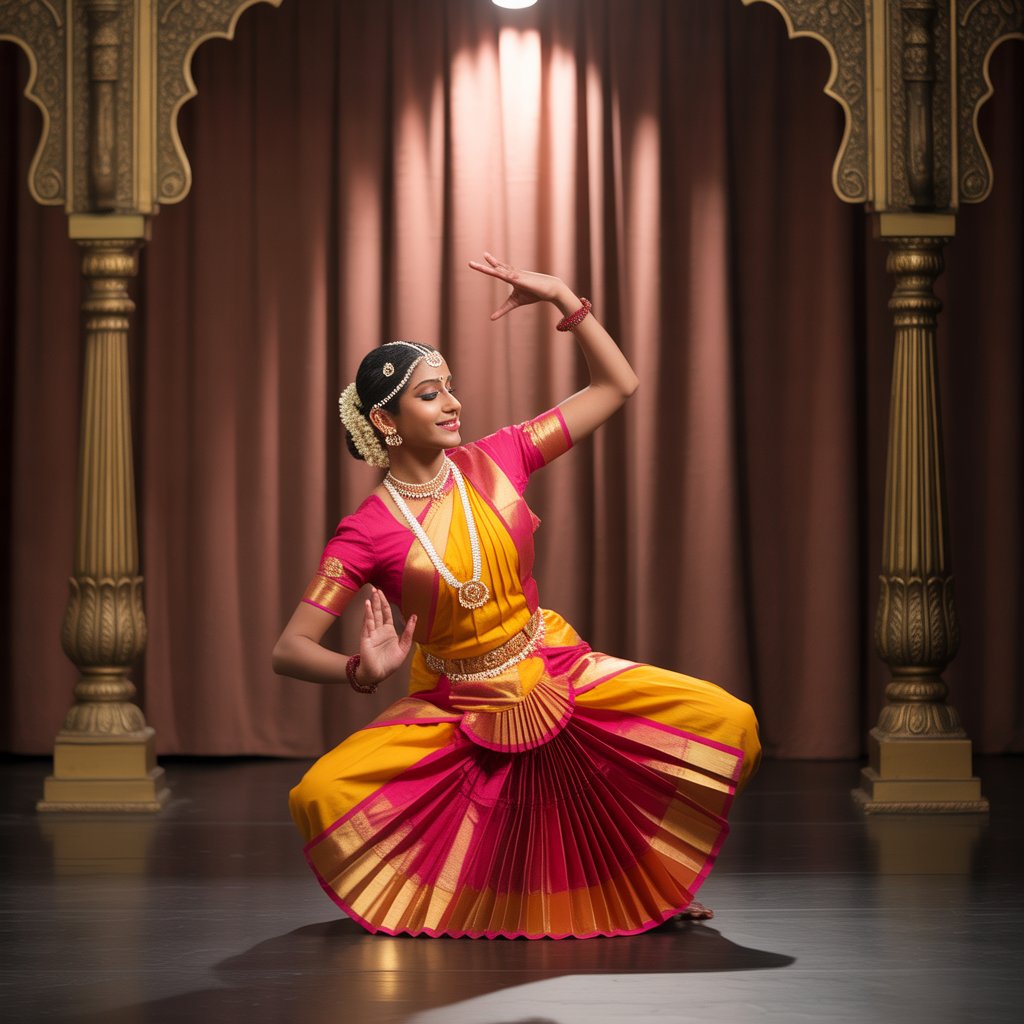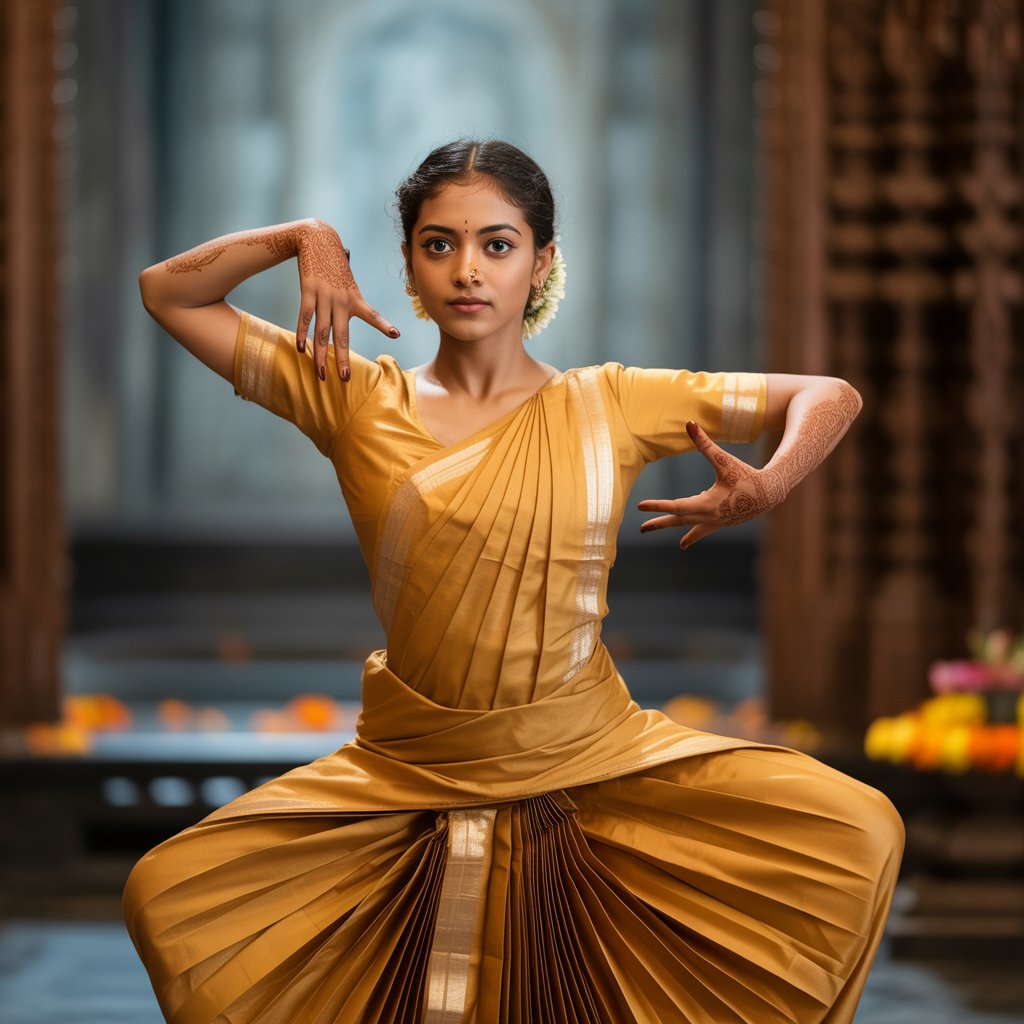
Bharatnatyam, a preeminent Indian classical dance form, is regarded as the mother of many other Indian classical dance forms. Conventionally, a solo dance performed only by women, it originated in the Hindu temples of Tamil Nadu and eventually flourished in South India. The theoretical base of this form traces back to ‘Naatya Shastra’, the ancient Sanskrit Hindu text on the performing arts. A form of illustrative anecdote of Hindu religious themes and spiritual ideas, emoted by a dancer with excellent footwork and impressive gestures, its performance repertoire includes Nrita, nritya, and Naatya. Accompanists include a singer, music, and particularly the guru who directs and conducts the performance. It also continues to inspire several art forms, including paintings and sculptures, starting from the spectacular 6th to 9th century CE temple sculptures.
Origin of Bharatnatyam
The history of Bharatanatyam is a testament to the resilience and adaptability of this art form. Bharatanatyam originated from the text Natya Shastra and grew roots in temples with the intent of deepening the religious experience. From its sacred origins in temple rituals to its resurgence as a revered classical dance, Bharatanatyam continues to enchant audiences with its beauty, grace, and profound storytelling. It remains an integral part of India’s cultural heritage, embodying the rich traditions and artistic expressions of the land.
Ancient
The theoretical structure of Bharatanatyam is known as ‘Sadir’ and traces back to the foundational text on artistic expression, Naatya Shastra. Legends of Lord Brahma reveal him as the creator of Bharatanatyam, who performed the dance to sage Bharata, who in turn wrote the dance form into the Natya Shastra. The practice of the Bharatanatyam style got its start in South Indian temples, where Devadasi (dancers dedicated to serving the Lord as servants) performed this dance along with spoken services. Dated back to 300 BCE, this was the original performance style of Bharatanatyam.
Medieval
The practice continued and grew in popularity in South India. Many temples are adorned with sculptures of Lord Shiva in Bharatanatyam poses. The eastern gopuram of Thillai Natarajar Temple, dedicated to Lord Shiva, is adorned by sculptures of 108 Bharatanatyam poses that are carved into small rectangular panels. Additionally, inside of cave one of Karnataka’s Badami cave temples, Lord Shiva is displayed in a 5-ft tall sculpture as Nataraja, posing in the Tandava dance. This sculpture includes the 18 arms of Shiva expressing mudras (hand gestures) included in the school of Bharatanatyam.
Modern
At the start of British colonial rule, the invaders viewed the Devadasis of South India as disgraceful, equating the long-studied and religiously poignant Bharatanatyam tradition to the activities of courtesans. They instituted a ban on numerous classical Indian art forms, thus ending the custom of temple Bharatanatyam performances.
It wasn’t long before classical art revivalists began working together to resurrect the art form. Lawyer, activist, and classical artist E. Krishna Iyer became involved in the fight to revive this traditional style of dance until he was incarcerated on charges of nationalism and subsequently imprisoned. While in prison, Iyer advocated for the renewal of Bharatanatyam dance with theosophist and choreographer Rukmini Devi Arundale. Later, the two of them founded the Madras Music Academy, where they worked with the community to save Bharatanatyam dance, among other traditional art forms.

Evolution Through the Ages
Initially, a temple dance dedicated to devotion and storytelling, Bharatnatyam later found royal patronage during the Chola dynasty, flourishing as an art form of the courts. The Bhakti movement played a crucial role in keeping Bharatnatyam alive, emphasizing its devotional aspect. In the 20th century, Rukmini Devi Arundale revived and redefined Bharatnatyam, bringing it to the stage while preserving its spiritual essence.
Key Elements of Bharatnatyam
Bharatanatyam is extremely rich and expressive. Each gesture, pose, and movement has a specific meaning and is used to represent objects, animals, emotions, and mythological characters. Here are some of the main features of this dance form:
- Mudras:
Mudras are hand gestures that play a crucial role in Bharatanatyam. Each mudra has a specific meaning and is used to represent objects, animals, emotions, and mythological characters. For example, the “Alapadma” mudra is used to represent a flower, while the “Chandrakala Mudra” symbolizes the moon.
- Adavus:
Adavus are a series of basic steps that form the foundation of Bharatanatyam. Each adavu combines hand gestures, footwork and body postures. These steps are essential for building the basic vocabulary required for choreography and performing the main repertoire of any performance in a fluid and coherent manner.
- Bhava:
Bhava refers to the expression of emotions in Bharatanatyam. Dancers use their faces and bodies to convey a wide range of emotions, from happiness to sadness and anger. Bhava is essential to bring stories to life and connect with the audience.
- Rasa:
Rasa is an important concept in Bharatanatyam. It refers to the “essence” or “flavor” of a performance. Dancers strive to evoke the nine primary rasas: Shringara (love), Hasya (laughter), Karuna (compassion), Raudra (anger), Veera (valor), Bhayanaka (fear), Vibhatsa (disgust), Adbhuta (wonder), and Shanta (peace). Each rasa adds depth and meaning to the performance.
- Abhinaya:
Abhinaya refers to narration and expression in Bharatanatyam. Movements and gestures are combined with facial interpretation and acting to tell stories of gods, mythological characters, heroes, and heroines. Abhinaya is a crucial skill that requires years of practice to master.
Costumes and Makeup
Bharatnatyam costumes are a visual treat—colorful sarees stitched for easy movement, adorned with temple jewelry, and complemented by expressive eye makeup. Each element has a symbolic meaning, enhancing the dancer’s storytelling abilities.
Music and Instruments
The Bharatnatyam dance is performed on Carnatic classical music. Although the modern revival of the dance form has given it some leniency with respect to music the original dance form was based on Carnatic music. The major instruments used in the dance form includes the following,
- Mridangam
- A pair of cymbals
- Veena,
- Violin,
- Ghatam and
- Flute
The language used during the recitation of verse may be Sanskrit, Tamil, Kannada and Telugu. The costumes used for the dance performance include the ‘Paijema’ or Dhoti. The top jacket is made of Kanchipuram silk and Banaras silk. Women who primarily perform the Bharatnatyam dance, wear a tight-fitting bodice of the same colour and material as the dhoti.
Modern-Day Bharatnatyam
Today, Bharatnatyam transcends borders, with dancers performing on global stages and incorporating contemporary themes while maintaining its classical roots. Renowned artists like Alarmel Valli, Malavika Sarukkai, and Priyadarshini Govind continue to inspire new generations of performers.
Rukmini Devi Arundale
Among the people who are credited for the revival of the Bharatanatyam after the suppression of the colonial government was Rukmini Devi Arundale.
An Indian classical dancer and theosophist born in 1914, she’s most known for being the one that managed to change public perception of the Bharatanatyam as a low-class dance form to a respected art form.
Meenakshi Sundaram Pillai
Meenakshi Sundaram Pillai was one of the greatest gurus and choreographers of Bharatanatyam. He was among the group of people credited with reviving the dance form and making it accessible to a wider audience.
While Rukmini Devi Arundale was known for her effort to sanitize the dance, Pillai is known for his contributions to the Bharatanatyam dance technique, including the development of a standardized format for teaching the dance.
He also created several new dance items and choreographed new pieces for the dance repertoire. Much of the Bharatanatyam classes taught today use his teaching methodology, which is one of the many things that Pillai left as his legacy to the classical dance community in India.
Mrinalini Sarabhai
Mrinalini Sarabhai (1918-2016) was a renowned Indian classical dancer and choreographer. But she’s most known for being an educator and an instructor.
In 1949, she established the Academy of Performing Arts in Ahmedabad, India, which became a well-known institution for the training of classical dancers and theatre artists.
The academy still runs today, producing generations of artists and dancers that keep the tradition going in India.
Sarabhai also received numerous awards for her contributions to the arts, including the Padma Bhushan in 1992 and the Padma Shri in 1965.
Conclusion
Bharatnatyam remains a living tradition—a dance form that unites devotion, culture, and artistic excellence. Whether performed in temples or on international stages, its grace and depth continue to resonate with audiences worldwide.



